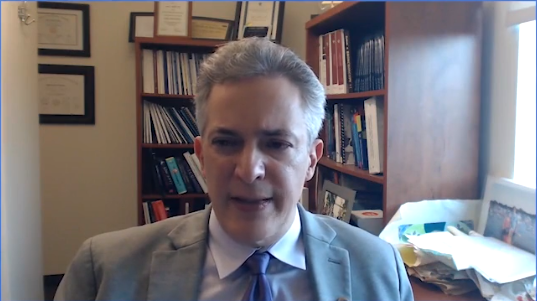
The 2021 Annual Congress of the American Thoracic Society (ATS) was held between May 14th and 19th and showcased the latest advances and breakthrough discoveries that will reshape the future of respiratory science, patient care and global respiratory health. A robust scientific, educational and networking programme was delivered via the virtual ATS platform, which included clinical and scientific sessions, keynote series, postgraduate courses and meet the expert sessions.

Juan Celedón, ATS President
ATS 2021 got underway with the opening ceremony and an address by current President Juan Celedón, who highlighted the extreme challenges of the past year which ATS has addressed with advocacy and a renewed focus on its over-arching mission to advance research and careers, clinical care and public health. Incoming President-Elect Lynn Schnapp then outlined key priorities and opportunities for the year ahead which include infrastructure upgrades, the leveraging of new learning methods and technologies and an increased focus on collaboration and knowledge-sharing.
“This past year, a once-in-a-century catastrophe has revealed the character and commitment of our ATS members who confronted the COVID-19 pandemic with selfless devotion to prevent further suffering and help those afflicted.”
ATS President, Juan Celedón
COVID-19

New antiviral targets for SARS-CoV-2 replication
Recent decades have seen an acceleration in the emergence of zoonotic coronaviruses with pandemic potential warned Mark Denison, Nashville, USA, as he reviewed SARS-CoV-2 replication and potential targets for countermeasures. Dr Denison highlighted remdesivir and molnupiravir (EIDD-2801) as two key drugs in the antiviral arsenal, both of which are able to prevent infection when used early. Remdesivir, the first approved COVID-19 antiviral, is administered intravenously and acts as a delayed ‘stop sign’ that ends RNA synthesis. Molnupiravir, an oral agent currently in Phase II/III testing, causes mispairing and mutations in the virus building blocks that damage RNA. Future research will look at combinations of remdesivir and molnupiravir and potential impact on resistance and fitness, as well as exploring new antiviral targets and combinations.
COVID-19 as a Catalyst for Change
COVID-19 has placed unprecedented pressure on health systems to rapidly embrace virtual care delivery. This session examined the evolving landscape of telemedicine and the virtual provision of both care and education, with a focus on practical lessons for respiratory clinicians.
Muna Irfan, Minnesota, USA, reviewed the potential of tele-sleep medicine which involves the use of electronic communications technology to provide sleep care at a distance. Key examples include patient portals, eConsults, video visits and remote patient diagnostics, monitoring and management.
Vincent Fan, Seattle, USA, explored the implications of COVID-19 on self-management among patients with COPD. Telemedicine approaches can provide access to self-management training (for example on inhaler technique), with televideo visits or web/app-based intervention proving feasible alternatives to in-person training which also benefits from being more scalable.

“The rapid increase of video visits during the COVID-19 pandemic may increase the acceptability of telemedicine self-management education.”
Vincent Fan, Seattle, USA
The impact of COVID-19 on ICU visitation, with 98% of hospitals in the US adopting a no-visitor policy and 4 out of 5 moving to telephone/video conferencing for communication with families, was discussed by Tom Valley, Ann Arbour, USA. Dr Valley concluded that, although restrictions were imposed to protect public health, they had major implications for patients and families, as well as an effect on overall healthcare outcomes.
Medical education in the era of telemedicine was examined by Lekshmi Santhosh, San Francisco, USA. Dr Santhosh advised that it is important to consider asynchronous versus synchronous approaches and the social learning environment when pivoting to virtual education. A sound grasp of resources for virtual education in pulmonary and critical care is also key and potential biases in virtual recruitment must be borne in mind.
The issue of whether telehealth is ‘friend or foe’ to health disparities was considered by Michelle Sharp, Baltimore, USA. Dr Sharp concluded that telehealth may improve geographic disparities if connectivity is in place and improve economic disparities related to working. However, it can worsen disparities for those lacking resources or with low digital literacy.
Closing Remarks
Looking ahead to next year’s congress, ATS is planning a live, in-person event in San Francisco which will be complemented by a rich array of online content. This hybrid conference will take place in May 2022, with final dates to be confirmed.
©Springer Healthcare 2021. This content has been independently selected and developed by Springer Healthcare and licensed by Roche for Medically. The topics covered are based on therapeutic areas specified by Roche. This content is not intended for use by healthcare professionals in the UK, US or Australia. Inclusion or exclusion of any product does not imply its use is either advocated or rejected. Use of trade names is for product identification only and does not imply endorsement. Opinions expressed do not reflect the views of Springer Healthcare. Springer Healthcare assumes no responsibility for any injury or damage to persons or property arising out of, or related to, any use of the material or to any errors or omissions. Please consult the latest prescribing information from the manufacturer for any products mentioned in this material.